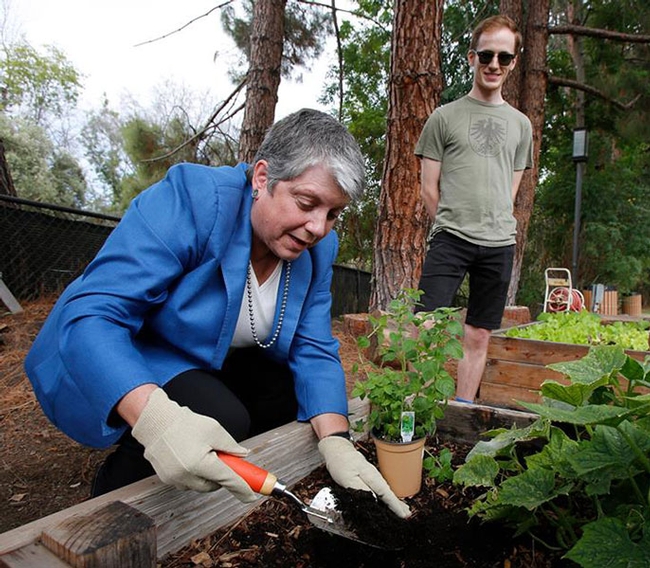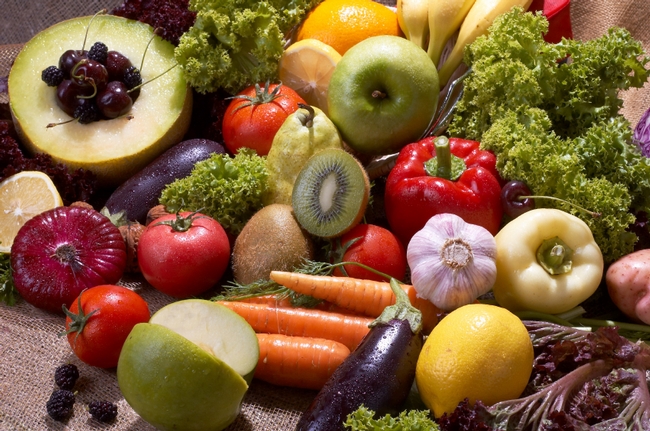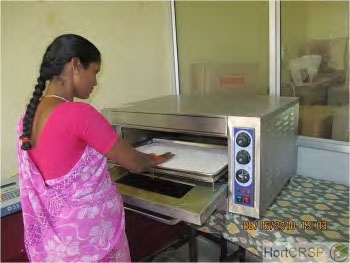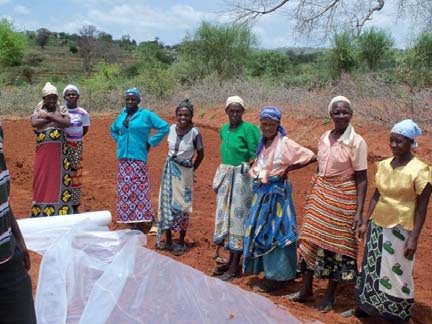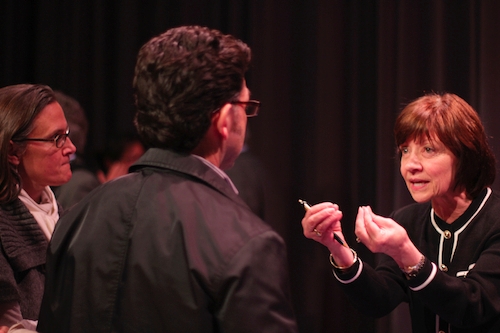Posts Tagged: sustainability
President Napolitano launches UC Global Food Initiative
On July 1, the University of California announced our new Global Food Initiative to address one of the critical issues of our time: How to sustainably and nutritiously feed a world population expected to reach eight billion by 2025.
UC's Division of Agriculture and Natural Resources is already a critical partner with California's farmers and consumers, providing growers and ranchers with scientifically tested production techniques, educating families about nutrition, improving food safety and addressing environmental concerns. With programs in every California county, our research and extension network in California reaches from Tulelake to El Centro and more than 130 countries working to solve agricultural problems at home and abroad.
The initiative will align the university's research, outreach and operations in a sustained effort to develop, demonstrate and export solutions — throughout California, the U.S. and the world — for food security, health and sustainability.
Check below for some key highlights from UC ANR and our 10 campuses. For more information about the initiative, visit: http://www.ucop.edu/initiatives/global-food-initiative.html
UC ANR
- In the past 10 years, 500 million citrus trees have been grown from disease-free budwood provided by Lindcove Research and Extension Center (REC).
- Desert REC has 1,300 carrot varieties in production for USDA's carrot improvement program.
- California became one of the leading producers of fresh blueberries after UCCE researchers identified varieties that could thrive in California, so long as the growers acidify the soils and maintain acidic conditions in the irrigation water.
- 5,400 UC Master Gardener volunteers play a key role in helping Californians grow food in their own backyard, working in 50 California counties to teach research-based gardening techniques that minimize the use of pesticides and artificial fertilizers. Currently, more than 1,200 community, school and demonstration gardens in California are managed by UC Master Gardeners.
- Through our Expanded Food and Nutrition Education Program (EFNEP) and UC CalFresh Nutrition Education Program (also known as SNAP-ED), UC Cooperative Extension works with community agencies and schools todeliver nutrition education to low-income families, improving their health and food security and helping preventchildhood obesity. EFNEP and CalFresh programs are currently operated in 33 counties reach 222,000 members of the public each year.
UC Berkeley
- The Berkeley Food Institute (BFI) is an interdisciplinary institute launched in 2013 dedicated to research, education, policy initiatives and practices to support sustainable food and agriculture systems. BFI is catalyzing and fostering transformative changes in food systems, to promote resilience, justice, diversity and health, from local to global scales.
- The Atkins Center for Weight and Health (CWH) works with community groups to develop and evaluate programs to support healthy eating and active living, with a focus on children and families in diverse communities.
UC Davis
- As the largest UC campus, with more than 3,000 acres specifically devoted to agricultural research and teaching, UC Davis is addressing the pressing food and agricultural challenges that face California, the nation and the world.
- In addition to the World Food Center, UC Davis hosts 26 centers with a significant emphasis on agriculture and food, including the UC Agricultural Issues Center, Agricultural Sustainability Institute, Center for Produce Safety, Foods for Health Institute, Seed Biotechnology Center, Postharvest Technology Center, Plant Breeding Center, Giannini Foundation of Agricultural Economics, Center for Food Animal Health, and Robert Mondavi Institute for Wine and Food Science.
- In April, UC Davis unveiled the largest anaerobic biodigester on a college campus, using technology invented by one of its engineering professors to turn organic waste into renewable energy. The system, now in commercial use, is designed to daily convert 50 tons of organic waste to 12,000 kWh of renewable electricity, diverting 20,000 tons of waste from local landfills each year.
UC Irvine
- Anthropologist Michael Montoya leads the Community Knowledge Project, an action-research partnership with community organizations in Santa Ana. Past projects have tackled obesity prevention and school lunch/food access. Upcoming project on diabetes prevention in Fullerton.
- In AY 2014-15, the Sustainability Initiative, in conjunction with social ecologist John Whiteley and UC Irvine's oceans faculty, will host a regional conference at the National Academies of Sciences' Beckman Center on Ocean Health, Sustainable Fishing, and Food Security.
- The Sustainability Initiative convenes The Garden Project, which coordinates the four campus community gardens (three of which are student-run) and builds links with the broader community involved in sustainable food production in Orange County, particularly in low-income communities.
UCLA
- The UCLA Center for Health Policy Research and the UCLA–USC Center for Population and Health Disparities — among other centers — are actively involved in research and community projects to help improve food availability and security.
- The Student Food Collective holds farmers markets in UCLA's main plaza and manages a food-buying co-op. Multiple produce gardens on campus increase sustainability practices, provide more healthful options and serve as educational tools to facilitate healthy lifestyle choices by the campus and surrounding community.
- The UCLA Mildred E. Mathias Botanical Garden promotes plant diversity and ecologically sound practices.
- UCLA faculty, students and staff collaborate with LAUSD food services and medical staff on research and programs to promote healthy eating for the school district's 600,000 students.
UC Merced
- Public Health Professor A. Susana Ramirez and her students this summer will interview with customers at a mobile farmer's market that travels to different parts of Merced County to better understand food access issues facing Merced County residents, and the relationship between access to healthy foods and obesity.
- UC Merced is working to form a Farmers Consortium to promote the campus's interest in doing business with local farmers, in addition to direct communication with local farms.
- UC Merced's 400-square-foot community garden was developed on campus in spring 2014 by Engineers for a Sustainable World. Fruit and vegetables harvested will be donated to local food banks. The site will eventually be used for education and outreach.
- The campus's Early Childhood Education Center serves as a delivery point for Rancho Piccolo, a community- supported agriculture. Many faculty and staff are members and are able to get local, fresh fruit and vegetables every week.
UC Riverside
- A chemist has applied chemical tests to juice products sold as pomegranate juice or pomegranate juice blends, in order to authenticate their content. Another researcher is studying the effects of pomegranate juice on prostate cancer progression.
UC San Diego
- Food and Fuel for the 21st Century supports the development of innovative, sustainable and commercially viable solutions for the renewable production of food, energy, green chemistry and bio-products using photosynthetic organisms — including converting solar energy into food and fuel, without the use of fossil fuels.
- Department of Literature students can enroll in “The Politics of Food” course that utilizes UC San Diego campus gardens for summer research. Students learn how community gardens are governed, planting their own seedlings and identifying campus markets for the produce they grow. In the Division of Biological Sciences, courses such as “Fundamentals of Plant Biology” introduce students to plant genetic engineering, plant disease and stress and sustainable agriculture.
- The UC San Diego School of Medicine's Child Development and Community Health program initiatives include Network for a Healthy California: Campaigns and programs focus on increasing fruit and vegetable consumption, physical activity levels and food security among low-income families. Healthy Works: This program initiates new farmers markets, promotes additional school and community gardens and helps residents to stay physically active and eat nutritious foods.
UCSF
- In 2009, UCSF launched the Smart Choice Smart U program http://smartchoice.ucsf.edu) in partnership with MyFitnessPal, a leading mobile application and website and Fitbit, an activity tracker, that combines food tracking with physical activity to give real-time feedback about personal wellness goals.
UC Santa Cruz
- The Center for Agroecology & Sustainable Food Systems (CASFS) at UC Santa Cruz has developed cutting-edge programs in food systems and organic farming research and extension, national and international work in agroecology, and a renowned apprenticeship program.
- The nearly 1,500 graduates of its Apprenticeship in Ecological Horticulture have carried hands-on experience into teaching, farming and advocacy positions worldwide for more than 45 years.
- An on-site affiliate, Life Lab, uses the Farm for K–12 school tours, teacher trainings, summer camps, and the “Food What?” youth empowerment program.
- The Central Coast School Food Alliance (CCSFA) is a collaborative initiative that serves school children fresh and wholesome food in Santa Cruz, San Benito, and Monterey counties. Stakeholders include food service directors, non-profit leaders on community food systems development, researchers, educators, as well as elected local, state, and federal officials.
World Food Center at UC Davis will tackle global issues
When you think casually of “food,” you may think of your next meal or your favorite food. “World food” may broaden your thinking to include international cuisines, global hunger, or a growing population. But the academic fields related to food are numerous. Food is one of life’s basic necessities, and along with its associated issues it is essential to the health and well-being of everyone, whatever their locale, education, or income level.
The new World Food Center at UC Davis will take on a broad purview related to food, including sustainable agricultural and environmental practices, food security and safety, hunger, poverty reduction through improved incomes, health and nutrition, population growth, new foods, genomics, food distribution systems, food waste, intellectual property distribution related to food, economic development and new technologies and policies.
With rapid global population growth occurring on smaller amounts of arable land, coupled with the expected impacts of climate change on food production, understanding the sustainability of food into the future is critical.
The new center’s website notes, “The World Food Center at UC Davis takes a ‘big picture’ approach to sustainably solving humanity’s most pressing problems in food and health. By bringing together world-class scientists with innovators, philanthropists and industry and public leaders, the center will generate the kind of visionary knowledge and practical policy solutions that will feed and nurture people for decades to come.”
In establishing the World Food Center, UC Davis Chancellor Linda Katehi said, “We did this to fully capitalize on our depth and expertise as the world’s leading university for education, research and scholarship on all aspects of food, but especially the nexus between food and health.”
UC Davis is the top-ranked agricultural university in the world, and California is the major producer of vegetables and fruit in the nation. Tom Tomich, director of the Agricultural Sustainability Institute and professor in the Department of Environmental Science and Policy at UC Davis, says of the World Food Center’s location at UC Davis, “There’s no place else that has the right mix of educational programs, research facilities, and the engagement with the state.”
The major academic disciplines surrounding food are found at UC Davis — agriculture, the environment, medicine, veterinary medicine, engineering, social and cultural sciences, and management. More than 30 centers and institutes at UC Davis will be pulled together through the World Food Center. The combination of scholarship, leadership, and partnerships at UC Davis has already established the campus as a center for food-related science and outreach. This new center will reinforce that strength and broaden the university’s ability to tackle tough global issues related to food.
Although the founding director of the center has yet to be named, Josette Lewis, Ph.D., was recently appointed as the associate director of the World Food Center. Her background on international research and development for the U.S. Agency for International Development, and director of its Office of Agriculture, honed her skills to take on the World Food Center. It was at US AID that she worked on a major global hunger and food security initiative, establishing her expertise on issues related to global agricultural development and food security.
As the new World Food Center becomes fully developed, it will be well-positioned on campus to continue to solve the major global issues related to food that are a hallmark of UC Davis.
Additional information:
- World Food Center website
- UC Davis video on the World Food Center
- Key facts
- UC Davis Dateline article
- Sacramento Bee article
How do we sustainably feed 8 billion people by 2025?
Some of us spent our weekend in the garden or at the farmers market, obsessing over our fresh produce that will get us through the week. Some of us went to bed last night dreaming about a Frostie from Wendy’s and fries from McDonald’s. Still, others of us spent the weekend trying to make ends meet and scraping together barely enough food to feed our families. Bottom line – food is something we all have in common. It’s a universal language. Whether we pride ourselves on eating local and organic, constantly find ourselves in the fast food lines, or stress about how to feed our families each day, food joins us all together.
All 6, almost 7, billion of us.
But what happens when there are 8 billion of us? Will more and more of us spend our weekends trying to scrape together enough food? Will more and more of us start our own gardens and obsess over our fresh produce? Will farmers markets become the new Ralphs? Will we have enough water to feed ourselves? Will we have enough land? How do we sustainably feed 8 billion people by 2025?
“We’re going to have to produce more food in the next 40 years than we have the last 10,000. Some people say we’ll just add more land or more water. But we’re not going to (be able to) do much of either,” says William Lesher, former USDA chief economist.
This is a global issue. But as Californian's and residents of the world’s top agricultural producer, what is our role in meeting these challenges? On April 9, 2013, producers, geo-politicists, ethicists, economists, humanists and many others from around the world will come together to discuss the challenges surrounding our global food systems at the UCANR Statewide Conference: Global Food Systems Forum.
The Global Food Systems Forum will feature Mary Robinson, former president of Ireland and president of the Mary Robinson Foundation - Climate Justice, and Wes Jackson, founder and president of The Land Institute, as the keynote speakers. The program will include a Global Panel, discussing key issues such as resource limitations, ethnical quandaries, climate change, responsibilities, etc. A California Panel will also take place, tackling issues such as California responsibilities, productivity, policies, markets and research.
But this conversation isn’t just about UC Agriculture and Natural Resources. It’s about all of us. We all need to take a stand and advocate for our food. If you watch what you eat, you should join the conversation. If you love what you eat, you should join the conversation. If you worry about how you will eat in the future, you should join the conversation.
The public is invited to participate in this one-day event via a live online webcast. You can also join the ongoing conversation on twitter by following the hashtag #Food2025. Make your voice heard. Stand up for your food, and help shape our future global food systems.
Learn more about the Global Food Systems Forum and register to watch the live webcast at food2025.ucanr.edu.
Addressing nutrition and poverty through horticulture
Nutrition, food security and sufficient family incomes are challenges in many parts of the world. Half the world’s people live in rural areas in developing countries. Because hunger and malnutrition are often linked to poverty, providing economic opportunities through horticultural production not only helps family incomes, but also addresses food security and nutrition. Training women to produce and market horticultural crops in the developing world also helps provide a much-needed income stream for families with children.
UC Davis is addressing food security and economic development in Africa, Southeast Asia, Central America, and elsewhere, by coordinating an international horticulture program. The Horticulture Collaborative Research Support Program (Hort CRSP; pronounced "hort crisp") is one of 10 CRSP programs that focus on global food production and solving food and nutrition problems in developing countries. UC Davis leads the Hort CRSP, with funding support from the U.S. Agency for International Development (USAID).
Examples of projects conducted by researchers and educators throughout the world include:
- Inexpensive cold storage systems in rural, developing areas to prolong food longevity; see page 2
- Concentrated solar drying of fruits and vegetables in East Africa; see page 3
- Improving safety and quality of tomatoes in Nigeria; see page 3
- Smallholder flower production in Honduras for export markets; see page 3
The overarching goals of the Hort CRSP are to reduce poverty and improve nutrition and health of the rural poor, while improving the profitability and sustainability of horticulture in the developing world. Priorities in the Hort CRSP include gender equity, sustainable crop production, postharvest technology, food safety, market access, and financing. The program awards research funding in the U.S. and abroad to:
- Realize opportunities for horticultural development
- Improve food security
- Improve nutrition and human health
- Provide opportunities for income diversification
- Advance economic and social conditions of the rural poor, particularly women
Dr. Elizabeth Mitcham, UC Cooperative Extension specialist in the Department of Plant Sciences at UC Davis and director of the Hort CRSP, notes, “By harnessing the research, training, and outreach expertise of the land-grant universities in the U.S. to work with partners in developing countries, we can improve horticultural capabilities in much the same way that the land-grant system helped revolutionize American agriculture.”
In the three years since the program’s inception, several projects have been completed, and many are ongoing. The program’s website offers a plethora of information, along with newsletters that highlight individual projects.
The program also has a YouTube channel, with videos on Hort CRSP projects. Some of the videos are about projects that are especially important in developing countries, including:
- The TRELLIS project — bringing together graduate students and in-country development organizations; YouTube link
- Using cell phones to give real-time information to growers in rural areas of India; YouTube link
- Inexpensive cultivation practices for smallholder farmers; YouTube link
- Indigenous products increase incomes in Ghana; YouTube link
- Saving indigenous crop seeds in Southeast Asia for resource-poor farmers; YouTube link
UC Davis, ranked first in the U.S. on research related to agriculture, food science and nutrition, and plant and animal science, is positioned to serve global needs related to food and nutrition. Of the 10 CRSP programs administered by USAID, two of the programs are based at UC Davis — the Hort CRSP program, and the BASIS CRSP, which was highlighted in a recent Food Blog post and addresses financial issues related to agricultural productivity.
The U.S. Farm Bill: What's at stake?
The United States farm bill is up for renewal this year, and what goes into the $400 billion, 5,000-plus page piece of legislation will affect what tens of millions of Americans eat — and don’t eat — in the coming years. On April 5, UC Berkeley’s College of Natural Resources fired off an enlightening salvo in the public discourse, with a panel of heavy hitters calling on the public to let their voices be heard in the quest to, as panelist Karen Ross, Secretary of the California Department of Food and Agriculture, put it, “move farmers and eaters closer together.”
Looking at the bill’s history, it’s not surprising the two groups have been driven apart. The farm bill was implemented during the Great Depression in the 1930s in order to raise commodity prices and farmers’ incomes, said Gordon Rausser, UC Berkeley professor of agricultural and resource economics and the event’s moderator. The commodities it focused on — food grains, feed grains, dairy, tobacco and peanuts — became political powerhouses while much of the food on our dinner tables — fruits, vegetables, and nuts — were relegated to the category of “specialty crops.”
Broccoli and oranges … specialty crops? “That’s what we grow here in California,” Ross said. And that's what's on the U.S. Department of Agriculture’s food plate. In the past 15 years such growers have been taking a more active role in the farm bill to make sure they are not marginalized, she said.
Over eight decades the bill has morphed from a farm to a food bill, the panelists said. Seventy-seven percent of the bill now goes to support the federal Supplemental Nutritional Assistance Program (SNAP), the reinvention of the food stamps program.
Ken Hecht, just retired from his position as the director of the California Food Policy Advocates, reeled off some facts about the people who use SNAP:
- 50 percent are working households
- 93 percent are below the poverty level
- 50 percent of benefit recipients are children
- 75 percent are households with children
“There are 1.3 million children who are getting enough to eat because of this program,” Hecht said. “It avoids all those consequences of food insecurity that we all know about: lack of adequate nutrition, lack of adequate health, lack of academic opportunity and performance, lack of social development.” The program not only helps its participants, Hecht, said, but the rest of the people in the community as well.
In addition to SNAP, support for sustainable agriculture emerged as a theme of the presentation. For insight, In Defense of Food author and UC Berkeley journalism professor Michael Pollan offered the audience the perspective of a Martian: we Earthlings are now eating oil instead of eating sunlight. What he referred to as the “free lunch of photosynthesis” was swapped out, starting in the 1940s, for high-yield, industrialized farming that relies on pesticides, machines and giant feed-lots for animals. Pollan said that while farmers were enormously successful in achieving productivity goals, the environmental costs make agriculture second only to cars in fossil fuel production, and the producer of 20 to 30 percent of the country’s greenhouse gases. He recommends a simple criteria should be applied to every provision of the farm bill, from farmers market support to the SNAP program to obscure payment structures: “The question we should ask ourselves is, is this pushing agriculture back onto the sun or is it leaving it on the fossil fuel basis?” he said. “That’s the standard I think we need to apply.”
Ken Cook, president and co-founder of the Environmental Working Group, framed the issue in terms of dollars. “One cotton farmer in 2004 received $2 million. That’s the same amount of money we spent for the entire federal program devoted to organic agricultural research,” he said.
He emphasized the connection between good food practices and good environmental practices, and called SNAP EWG’s number one priority. “We’re trying to inject healthy eating into the farm bill as a legitimate concern of public policy,” he said. He cited a pilot healthy-snack program, in which evaluators noted students who had never seen a pineapple or celery or carrots before. “We should be spending billions of dollars on this program ... getting kids hooked on fruits and vegetables."
Cook pointed out that that much of what drives the farm bill is the politics of committee members securing subsidies for their home states, and conjured the specter of the recent pink-slime debacle to show how effective a little activism can be. Fail to get involved at your peril, Cook, said. “I guarantee you will get more of the same or worse.”
Pollan passed along advice from one of Cook’s staffers: “Simply calling your representative and saying you want more healthy food, you want more environmentally sustainable food, is all you need to do.”
The event was a presentation of the UC Berkeley College of Natural Resource's Spring 2012 Horace Albright Lecture in Conservation. Watch an hour and a half video of the presentations and Q&A:


